System Builder Marathon Q1 2015: Alternative $1750 PC
Benchmark Performance
We continue to use last quarter’s benchmark settings, enabling a comparison of both $1750 machines to the previous quarter’s $1600 build.
Test Hardware Configurations
| Header Cell - Column 0 | Alternative $1750 PC | Original Q1 $1750 PC | Q4 2014 $1600 PC |
|---|---|---|---|
| Processor (Overclock) | Intel Core i7-5820K: 3.3 - 3.6GHz, Six Physical Cores O/C to 4.13 - 4.5GHz, 1.18V | Intel Core i7-4790K: 4 - 4.4GHz, Four Physical Cores O/C to 4.6 - 4.8GHz, +20mV | Intel Core i7-4790K: 4 - 4.4GHz, Four Physical CoresO/C to 4.6GHz, 1.26V |
| Graphics (Overclock) | Gigabyte GeForce GTX 980: <1279MHz GPU, GDDR5-7012 O/C to <1504MHz, GDDR5-8012 | 2x PNY GTX 970: <1178MHz GPU, GDDR5-7012 O/C to <1328MHz, GDDR5-7312 | PNY GTX 980: <1216MHz GPU, GDDR5-7012 O/C to <1456MHz, GDDR5-7972 |
| Memory (Overclock) | 16GB Adata DDR4-2400 CAS 16-16-16-38, O/C to DDR4-3000 CL 16-16-16-32, 1.25V | 16GB G.Skill DDR3-1866 CAS 10-11-10-28, O/C to DDR3-2133 CL 11-12-11-24, 1.6V | 8GB G.Skill DDR3-2133 CAS 9-11-10-28, O/C to DDR3-2400 CL 10-12-12-28, 1.6V |
| Motherboard (Overclock) | MSI X99 SLI Plus: LGA 2011-v3, Intel X99Stock 100MHz BCLK | Gigabyte Z97X-Gaming 5: LGA 1150, Intel Z97 ExpressStock 100MHz BCLK | Biostar Hi-Fi Z97WE: LGA 1150, Intel Z97 ExpressStock 100MHz BCLK |
| Case | Corsair Graphite 230T | Corsair Graphite 230T | Thermaltake Chaser A31 |
| CPU Cooler | Cooler Master Hyper 612 Ver.2 | Corsair H100i Closed-Loop | Phanteks PH-TC14PE 140mm |
| Hard Drive | Crucial MX100 256GB SATA 6Gb/s SSD | Crucial MX100 256GB SATA 6Gb/s SSD | Plextor M6S PX-256M6S 256GB SATA 6Gb/s SSD |
| Power | Rosewill Capstone-750: 750W, 80 PLUS Gold | Rosewill Capstone-750: 750W, 80 PLUS Gold | Rosewill Capstone-750-M: 750W, 80 PLUS Gold |
| Software | |||
| OS | Microsoft Windows 8 Pro x64 | Microsoft Windows 8 Pro x64 | Microsoft Windows 8 Pro x64 |
| Graphics | Nvidia GeForce 347.25 | Nvidia GeForce 347.25 | Nvidia GeForce 344.75 |
| Chipset | Intel INF 9.4.0.1026 | Intel INF 9.4.0.1026 | Intel INF 9.4.0.1026 |
Synthetic Benchmarks
3DMark shows a slight lead in today’s GeForce GTX 980-equipped machine compared to Q4’s, and that difference is probably in clock frequency. My original GeForce GTX 970 SLI PC outclasses both.
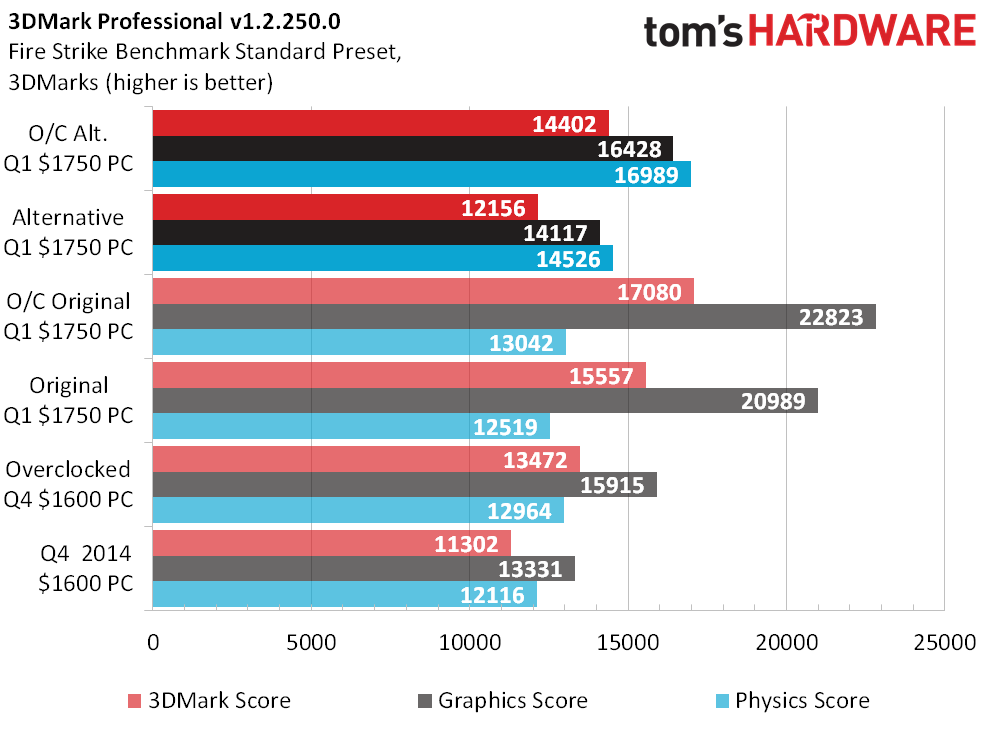
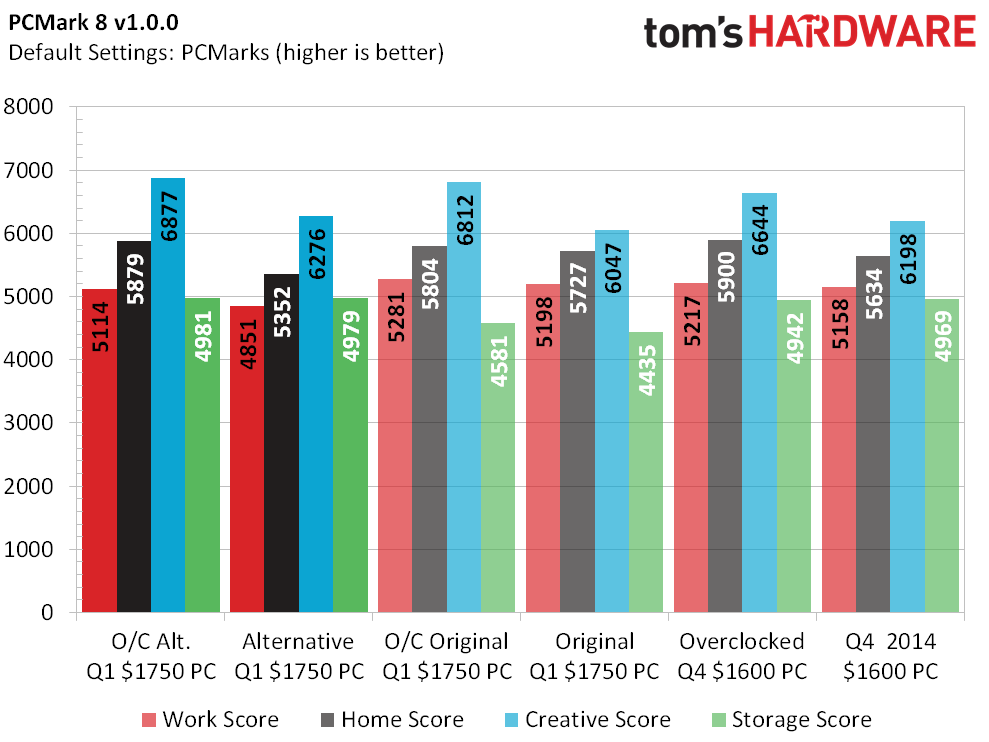
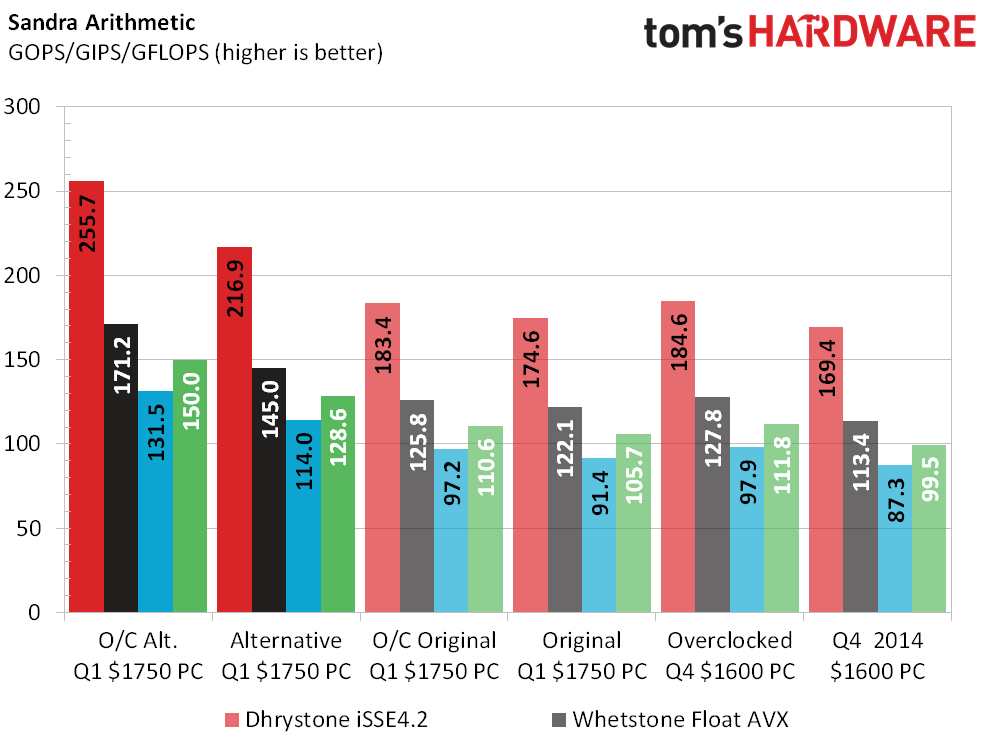
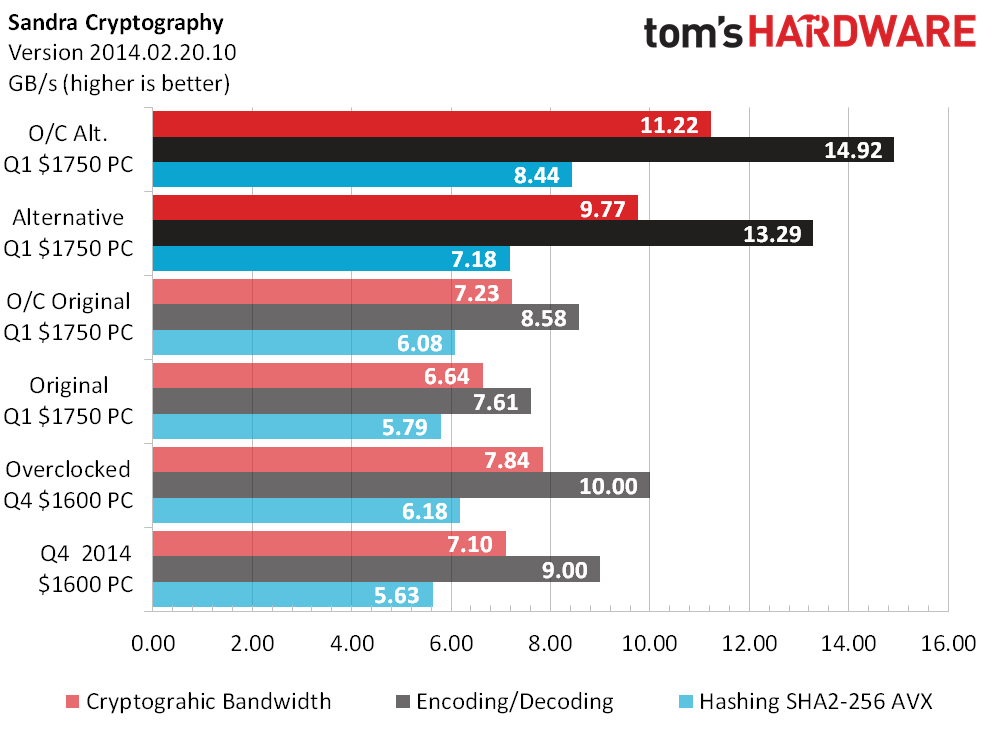
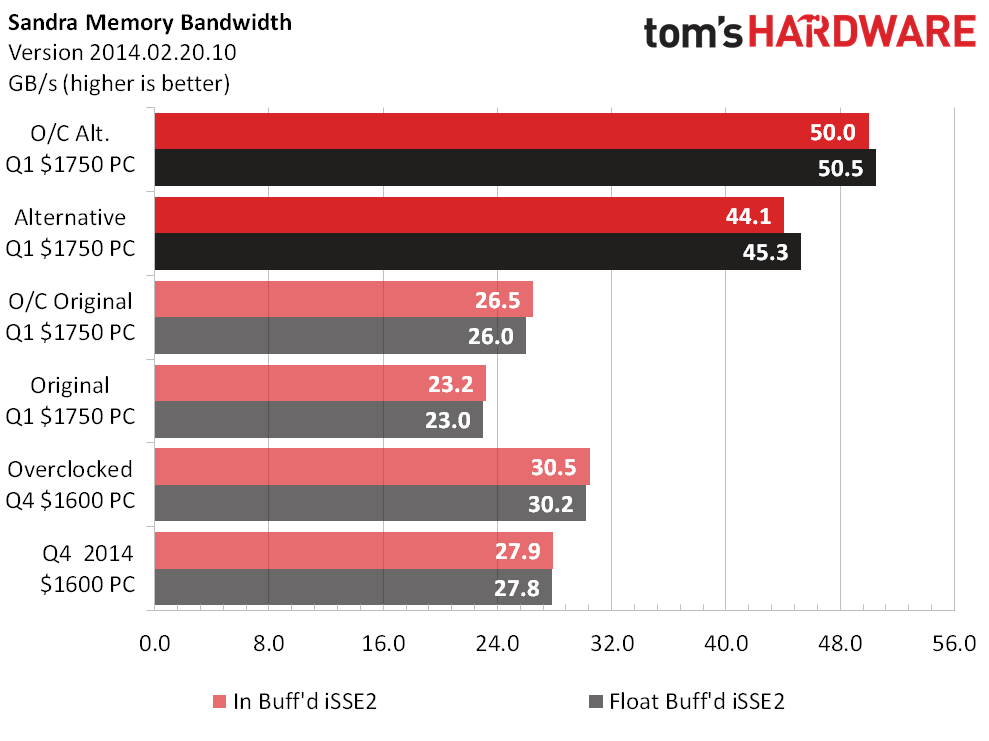
Sandra Arithmetic doesn’t show anything close to a 50% performance gain favoring the alternative build’s added CPU cores, but that’s probably because the processor is clocked over 20% slower. It looks far better in memory-intensive Encoding/Decoding cycles, and that’s probably because its quad-channel memory controller provides nearly twice the bandwidth.
3D Games
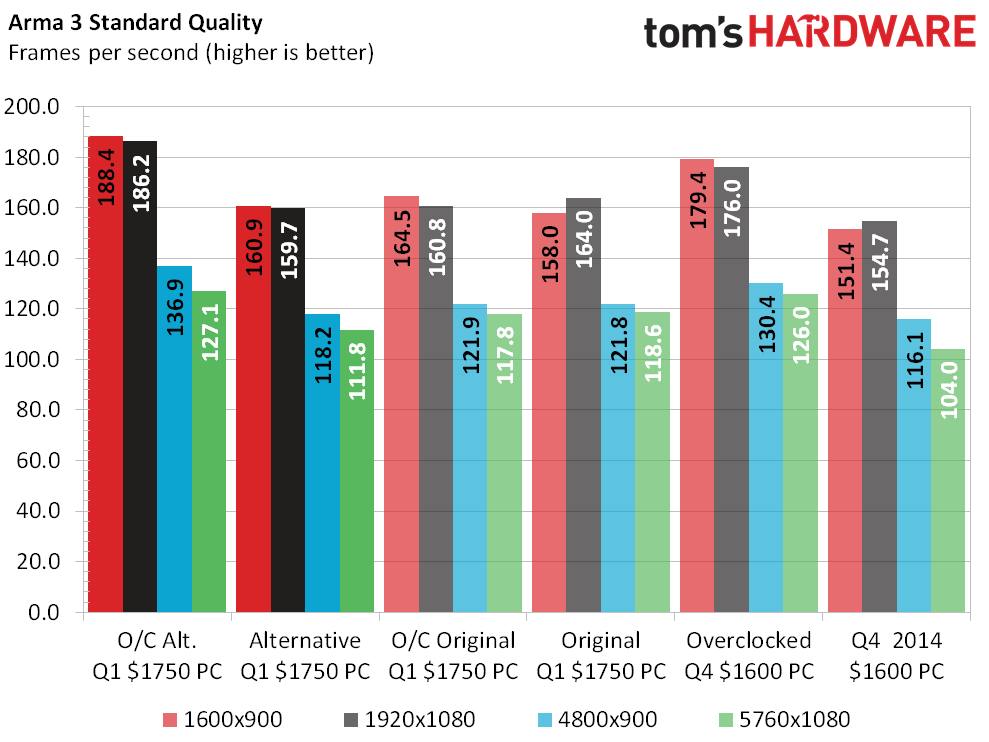
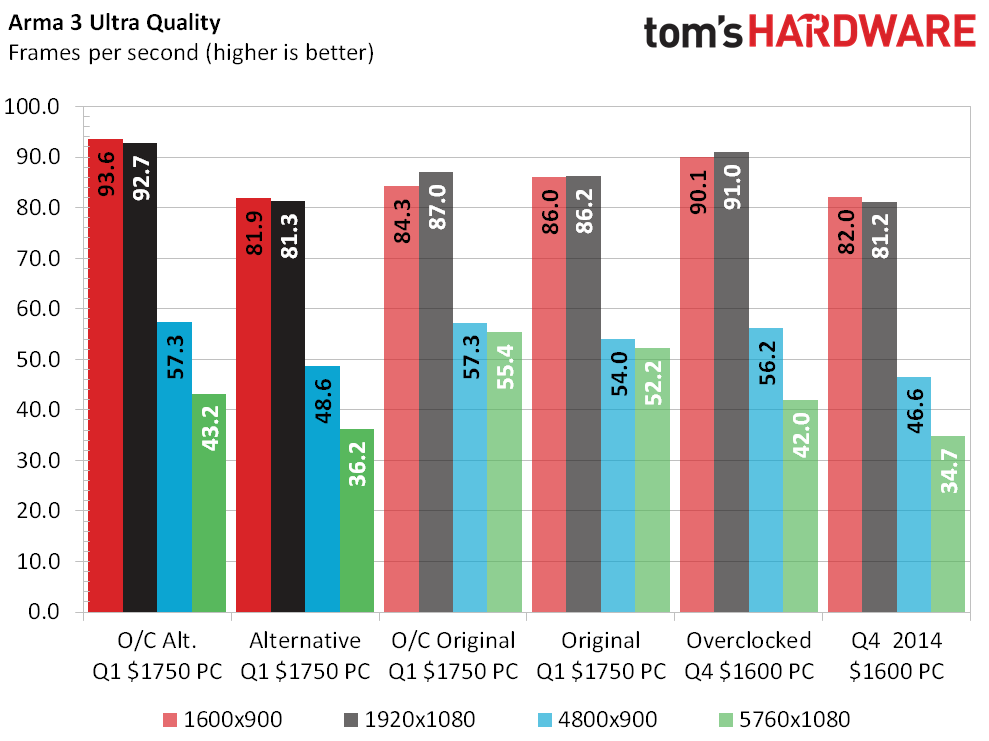
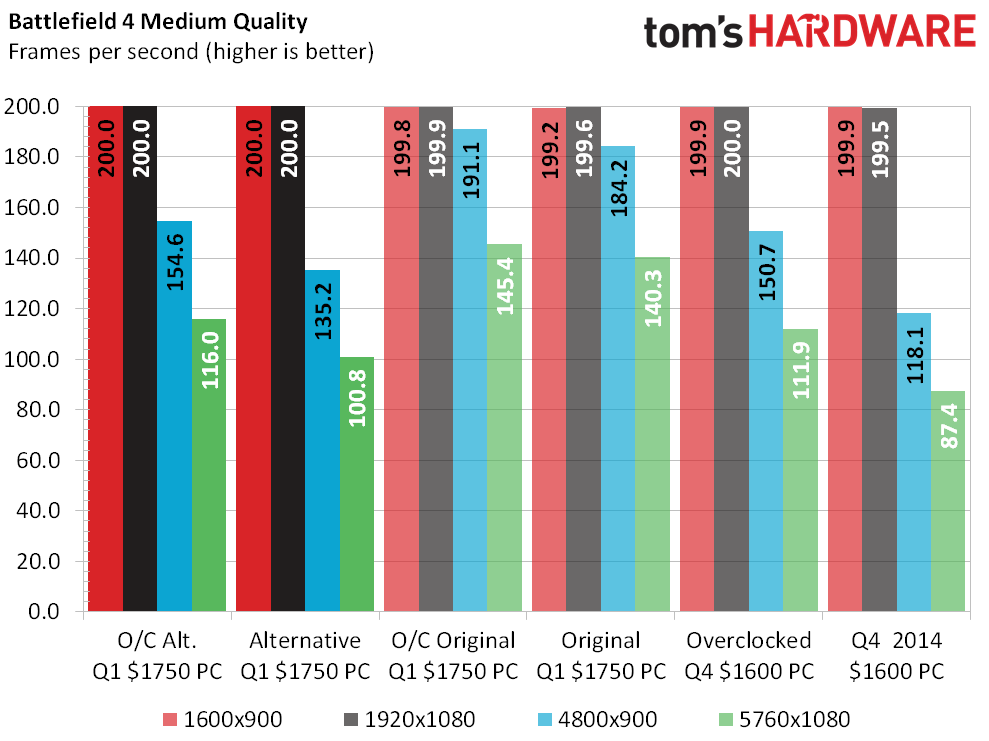
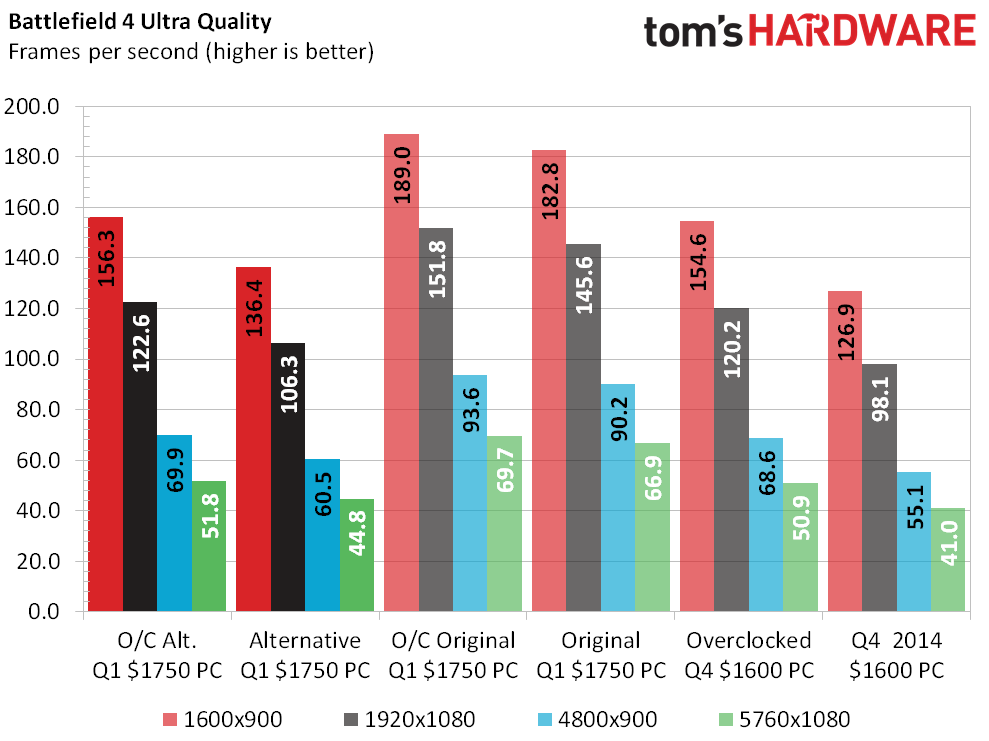
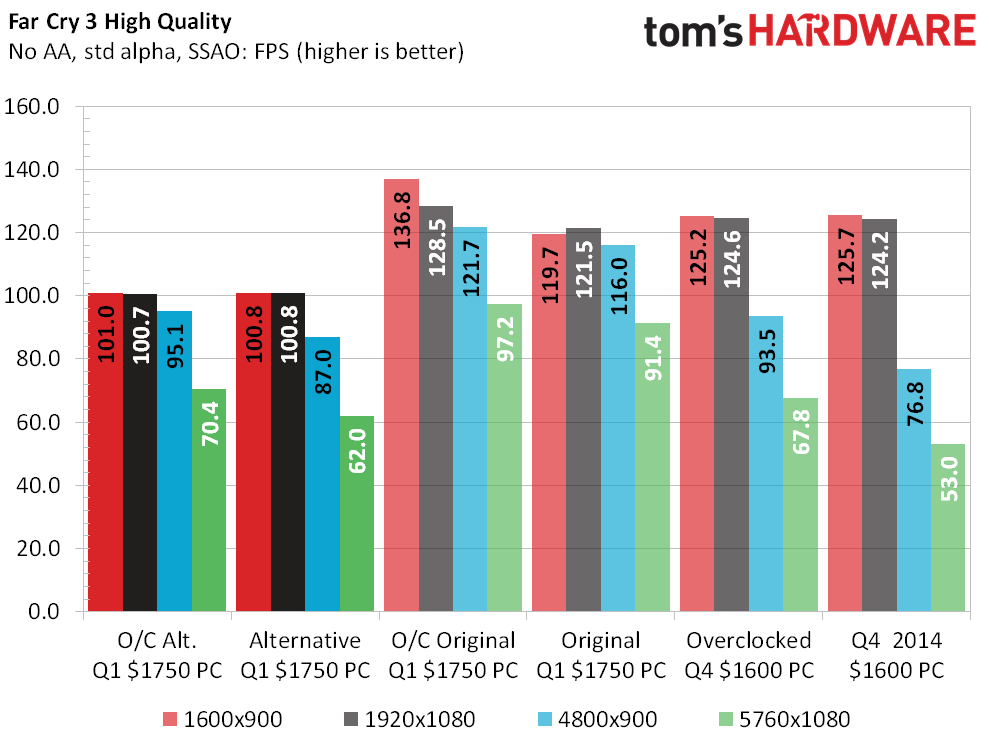
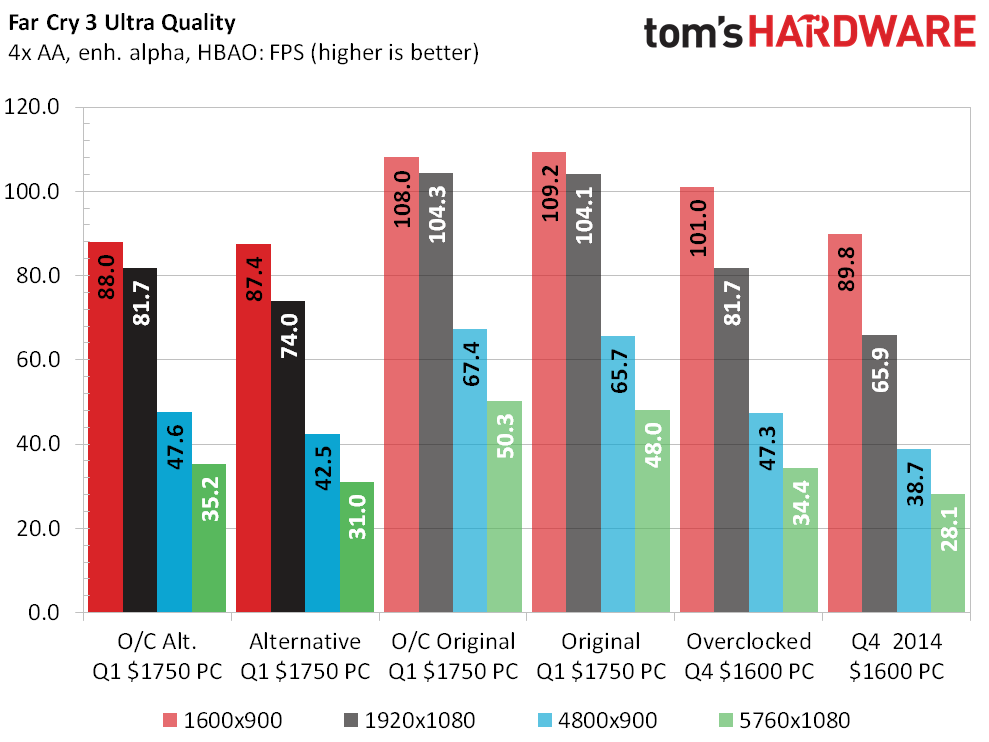
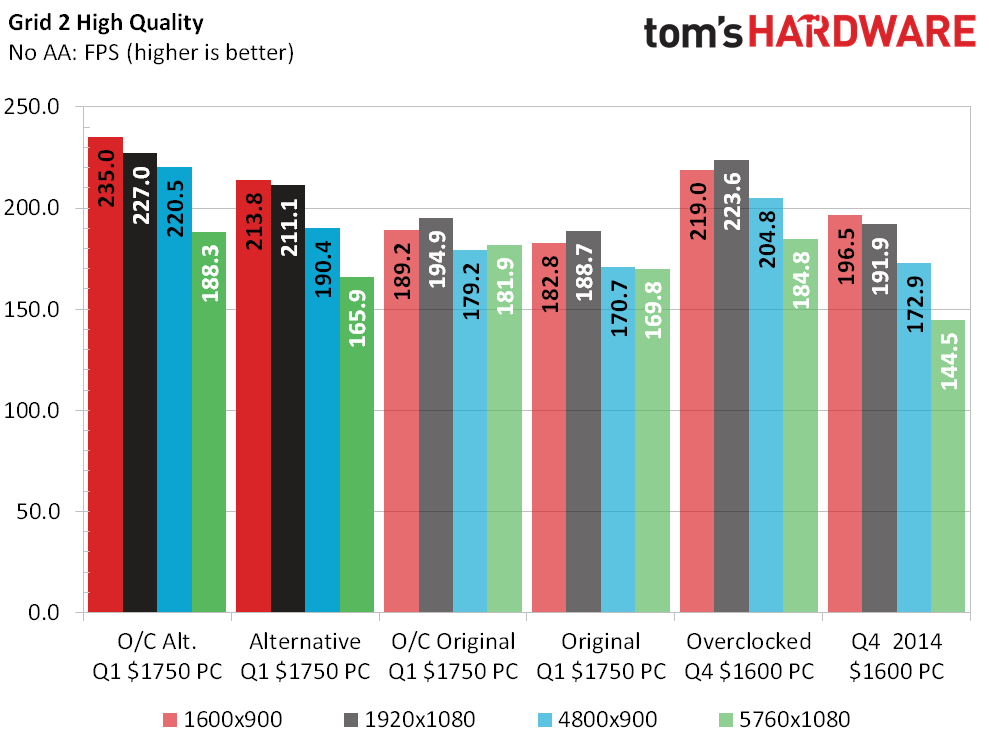
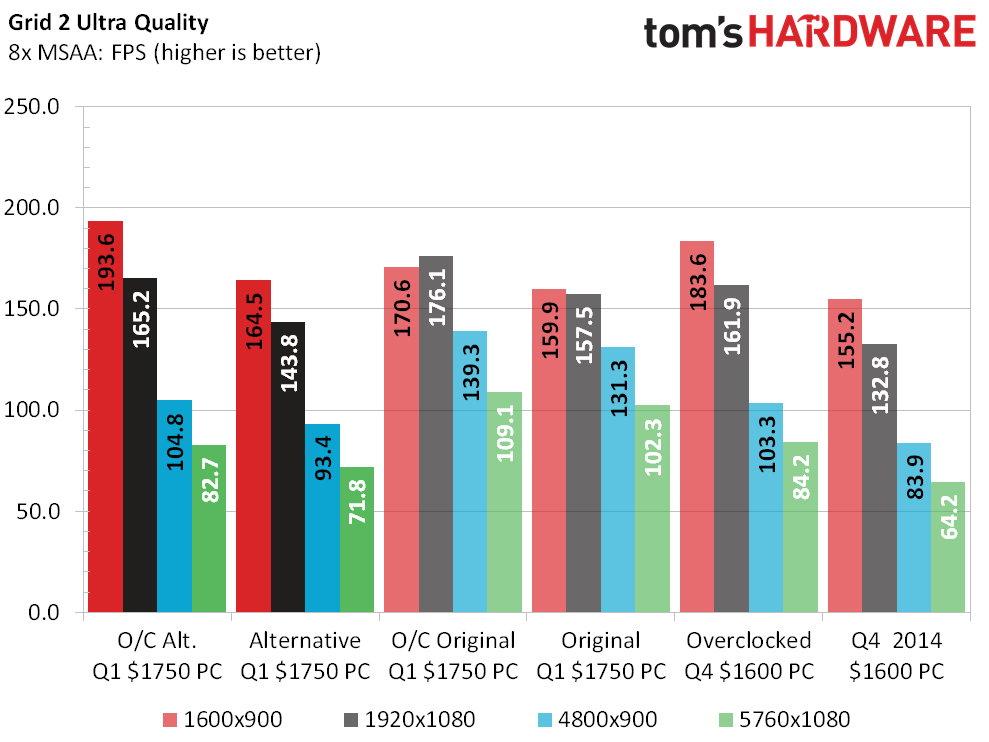
Arma 3 appears to benefit from my alternative build’s extra memory bandwidth at low to medium resolutions, while Battlefield 4 punishes its single graphics card at all but its most rudimentary (and FPS-capped) settings.
This quarter's single-card alternative build and the Q4 machine perform poorly by high-end standards in Far Cry 3's Ultra-quality preset, becoming slightly choppy at 5760x1080. Grid 2 is slightly more forgiving, offering the alternative build a hand up at lower settings in exchange for added memory bandwidth.
Audio And Video Encoding
The alternative build’s lower clock rate hurts it slightly in single-threaded audio encoding, but it quietly demolishes its quad-core cousins in threaded video workloads. A similar scenario plays out in Adobe's Creative Suite, where only OpenCL-based Photoshop filters find parity between the two GeForce GTX 980-based machines.
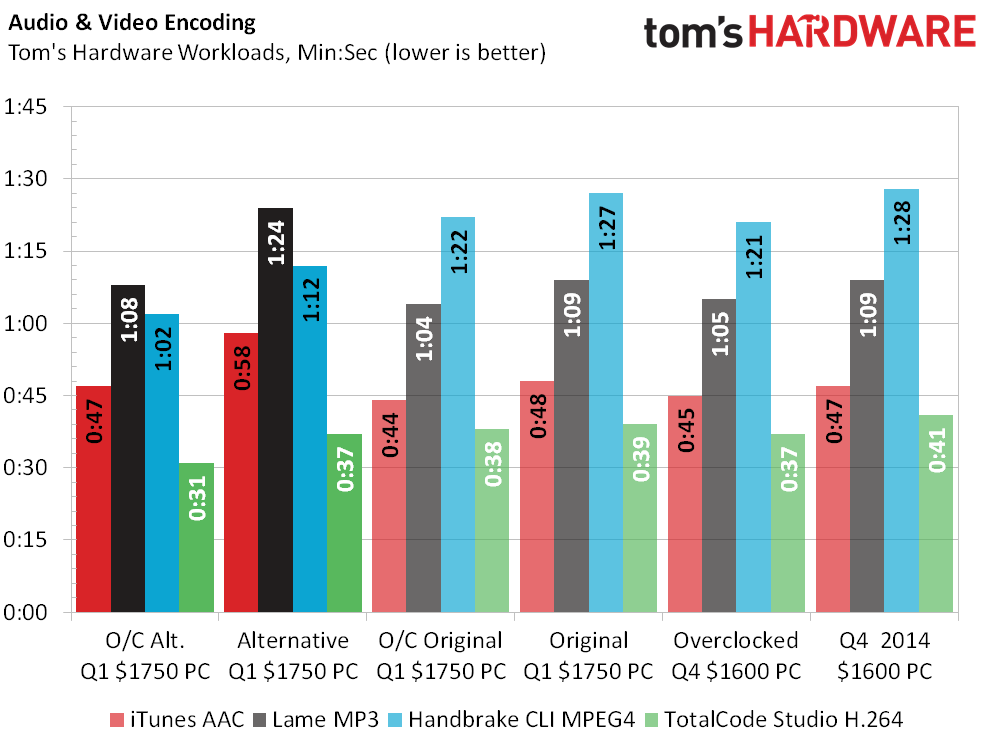

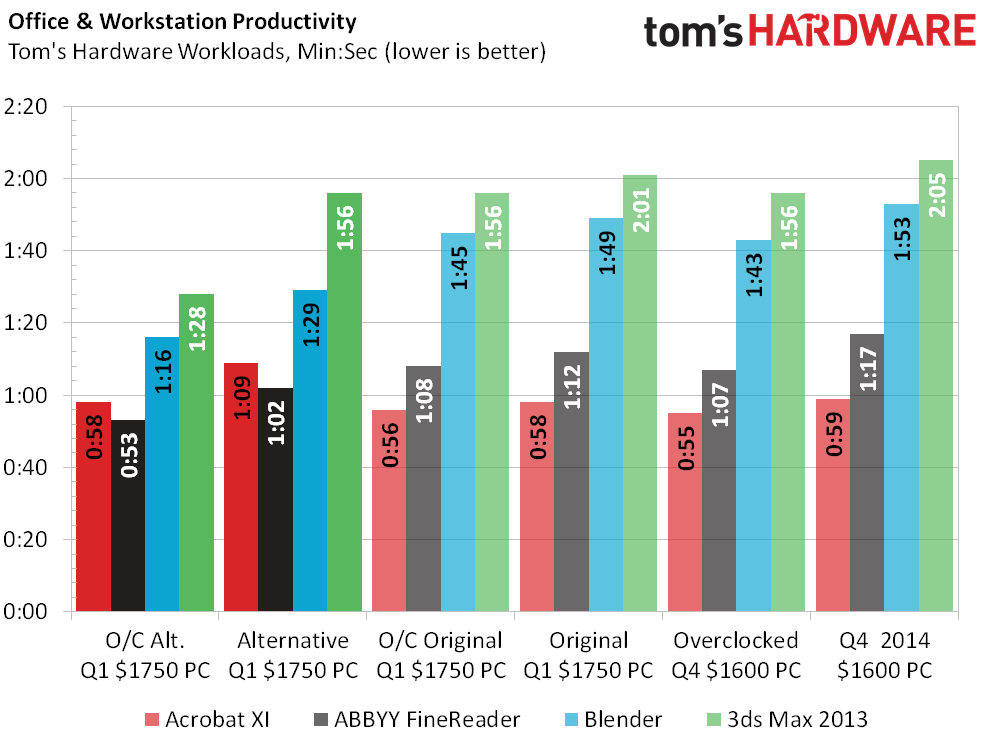
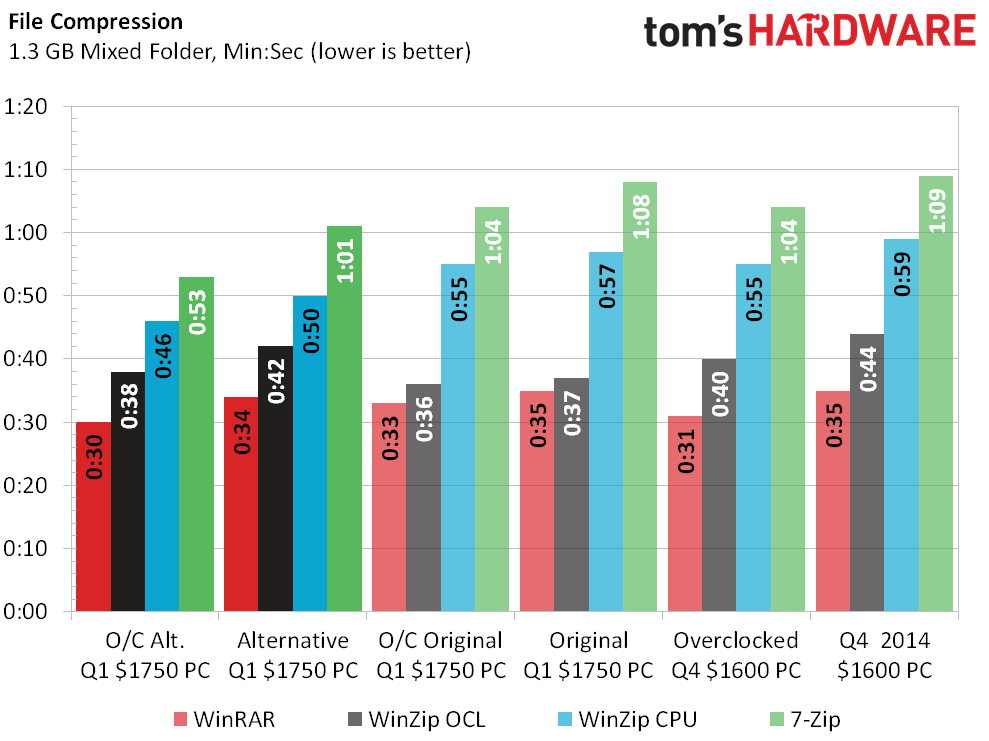
Adobe Acrobat prefers the previous machine’s high-frequency quad-core chip, while our OpenCL-accelerated WinZip metric appears to like the SLI machine’s GeForce GTX 970s. Everything else from our productivity and compression suites get at least some boost from the alternative build’s extra CPU cores, and it runs rendering applications (3ds Max and Blender) exceptionally quickly.
Get Tom's Hardware's best news and in-depth reviews, straight to your inbox.
Current page: Benchmark Performance
Prev Page Component Installation And Overclocking Next Page Power, Heat, Efficiency And Value-
Rancifer7 Its great to see a build that shows just how much of a difference a good CPU and updated architecture can make within the same budget. Well done, thank you.Reply -
Grognak "A smaller but equally vocal group of enthusiasts suggested that a six-core CPU would be the true answer to overall system performance"Reply
Yeah because as everyone knows, higher definitions need more cores, right? And we don't have thousands of benchmarks showing that there's less than 1% improvement between a regular i7 and an hexacore one when it comes to games. We also don't have benchmarks showing that the 4770k outperforms the 5820k in just about every game thanks to the higher frequency. Clearly this is worth the $200 premium and weaker graphics. -
Crashman Reply
Er, wow, OK! Thanks for the input!15392308 said:"A smaller but equally vocal group of enthusiasts suggested that a six-core CPU would be the true answer to overall system performance"
Yeah because as everyone knows, higher definitions need more cores, right? And we don't have thousands of benchmarks showing that there's less than 1% improvement between a regular i7 and an hexacore one when it comes to games. We also don't have benchmarks showing that the 4770k outperforms the 5820k in just about every game thanks to the higher frequency. Clearly this is worth the $200 premium and weaker graphics.
Edit: Just to clarify, you think we should ditch the non-gaming benchmarks right? -
damric To properly showcase the 6 and 8 core Haswells you need to be gaming while recording/streaming in high quality. The lesser CPUs, especially the quads without HT simply can't keep up at this task. There is a rapidly growing market for making videos of gameplay. Not my thing, but it's something I might attempt if I had the hardware to do it.Reply -
Gurg @Crashman Even though I don't know what most of the non-gaming benchmarks are used for, keep them for those for whom they are important. But from what I saw, in a pretty direct comparison, an overclocked 5820K beats a 4790k for ultra settings at higher resolutions.Reply
Seems like time to drop the 4790k and replace it with the 5820k in the March gaming CPU recommendations. The earlier Haswell E review also appears outdated as better bios, motherboards and ddr4 ram have become available. The cost difference between a 97 and 99 platform have also narrowed considerably. -
firefoxx04 He we go with the "more cores suxxxxxx dude!!!" comments.Reply
Do you idiots really think that people who spend over $1500 on a system ONLY play games? Really?
Some people do more than just game. They record their gameplay at top notch quality. Some people run lots of virtual machines. Some people like to run folding at home on a couple cores while gaming or doing other things. Video editors love lots of cores too.
When quad cores became mainstream everyone said "pointless!!! Because games only use 2 cores!!! That statement has turned into, "pointless!!! Games only use 4 cores!!!!.
The same thing was said about having lots of system ram. Remember when 64mb was the thing? Now im sitting here frustrated that my 8GB ddr3 set is not enough. Same thing with hard drive space. People always tell me, 500gb will take forever to fill up yet im sitting right here with 3TB of storage and I want more.
This refusal to let better hardware become mainstream is frustrating, and a majority of the people against more cores (and other things) are the same people that watched mainstream go from 2 cores to 4 cores in only a couple years. -
caj @firefoxx4Reply
i cudnt agree without you less. people always refer that i7 are just a waste of money but they forget th endless opportunities that a pc can perform. till now a i7 870 hasnt yet failed me from 4 gpus goin from a 6850, 7850, 7970 and finally 280x. i often use my computer for many purposes. like they say its better to have and not need than to need and not have. the same people who kept saying that 8gb is more than enough while right now i feel more comfortable with 16 gb -
MasterMace I agree with your decision to go with a 6 core Intel and not SLI your graphics, although I am curious as to the lack of a HDD for storage. At this pricepoint, removing the HDD is not something I feel to be appropriate. Perhaps at the $1200 pricepoint, you could use the SSD in lieu of the HDD, but at $1800, it feels mandatory. The problem is between your graphics and CPU you're using over 50% of your budget (which is great for gaming, funny enough)Reply

